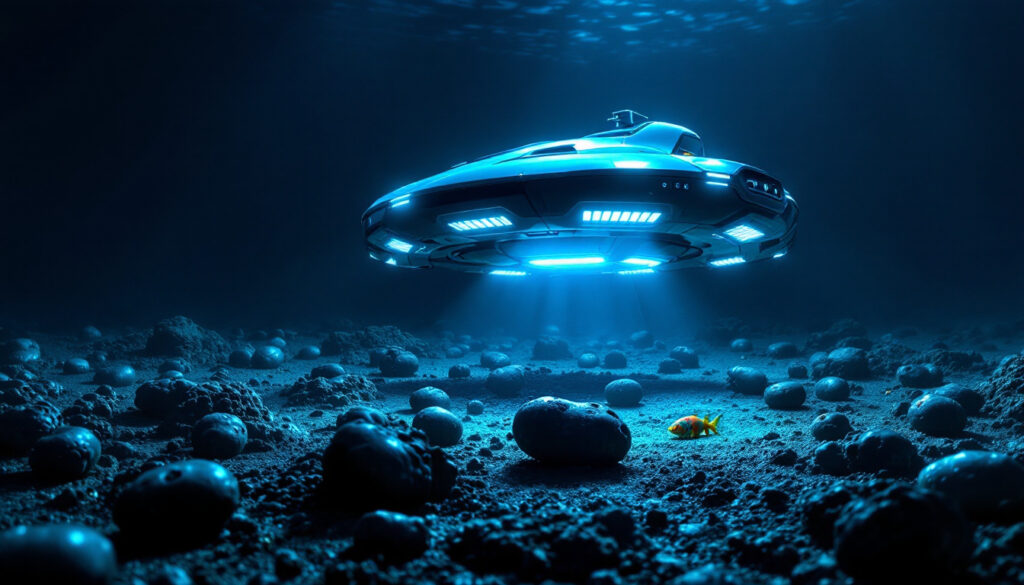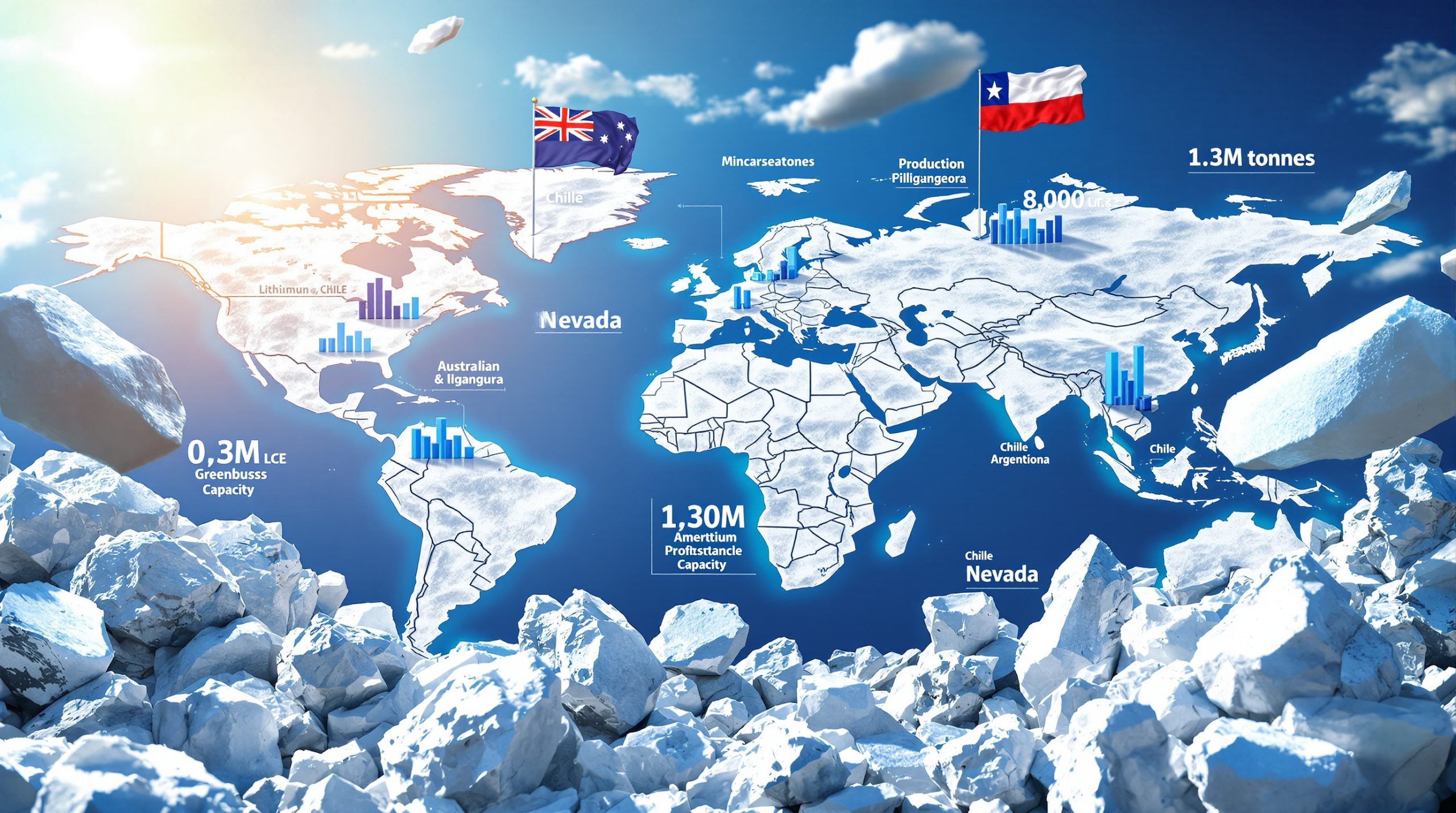What is Deep Sea Mining and Why is it Controversial?
Understanding Polymetallic Nodules
Polymetallic nodules are mineral-rich formations found on the ocean floor, composed of manganese, nickel, cobalt, and copper. These potato-sized rocks form over millions of years through the precipitation of metals from seawater and sediment pore water.
The nodules contain critical minerals essential for electric vehicle batteries, renewable energy technologies, and electronics manufacturing. With nickel content averaging 1.3%, cobalt at 0.3%, and copper at 1.1%, these resources represent a significant untapped reserve of strategic metals.
The Clarion-Clipperton Zone (CCZ) in the Pacific Ocean between Hawaii and Mexico contains the world's largest known concentration of these nodules—an estimated 21 billion tons spread across 4.5 million square kilometers of seabed. This single region contains more nickel and cobalt than all land-based reserves combined.
Environmental Concerns with Traditional Methods
Conventional deep sea mining approaches, developed in the 1960s-70s, employ dredging tractor systems that scrape the seabed. These methods create massive sediment plumes that can travel thousands of kilometers, smothering marine life and disrupting deep ocean ecosystems.
Traditional mining vehicles crush everything in their path, including fragile deep-sea corals, sponges, and other marine organisms that may take centuries to recover, if they recover at all. The noise pollution from these operations further impacts marine mammals and fish populations.
Research indicates that deep-sea ecosystems contain unique biodiversity with potential for medical and scientific breakthroughs. A single mining operation using conventional technology could impact 5,000-10,000 square kilometers of ocean floor—an area larger than many national parks.
Economic and Geopolitical Implications
The global transition to clean energy has intensified demand for critical minerals, creating supply chain vulnerabilities. Currently, 75% of the world's nickel comes from Indonesian rainforests, with mining operations causing significant deforestation, water pollution, and social displacement.
Deep sea mining presents a potentially more sustainable alternative, with Impossible Metals estimating it could be 20 times less expensive than average nickel mines while reducing environmental impact. This cost advantage comes from the higher grade of minerals in nodules and the efficiency of autonomous collection systems.
The geopolitical implications are substantial, as deep sea mining could reduce dependence on politically unstable regions and diversify the supply chain for critical minerals. However, this disruption threatens existing mining interests, creating powerful opposition from countries with significant land-based mining operations.
How Does Impossible Metals' Technology Work?
Autonomous Underwater Vehicles (AUVs) System
Impossible Metals has developed an innovative approach using Autonomous Underwater Vehicles that hover approximately one meter above the seabed—a significant departure from conventional systems that make direct contact with the ocean floor.
The AUVs employ a mechanical arm array rather than vacuuming or suction methods, allowing for selective nodule collection without disturbing the surrounding environment. This precision approach enables the vehicles to leave behind nodules that serve as habitat for marine organisms.
A proprietary buoyancy engine powers vertical movement, allowing the AUVs to rise to the surface efficiently after collection without using energy-intensive thrusters. Once at the surface, the vehicles undergo battery swaps and automated crane recovery, enabling continuous operations with minimal surface vessel requirements.
AI-Powered Marine Life Detection
The AUVs are equipped with stereo lights and cameras that scan the seabed ahead, creating a detailed three-dimensional map of the environment. This visual data feeds into NVIDIA graphics processors running proprietary algorithms that distinguish between nodules and marine life in real-time.
When the system identifies marine organisms, it creates virtual quarantine zones around them, ensuring that collection arms don't disturb these protected areas. This technological approach enables Impossible Metals to commit to leaving 60% of nodules (by number) and 30% (by mass) undisturbed, preserving habitat complexity.
The AI in mineral exploration continuously learns and improves through each deployment, becoming increasingly accurate at differentiating between various species and nodule types. This adaptive capability allows the system to operate effectively across different seabed environments and conditions.
Sediment Plume Reduction
Traditional mining methods create massive sediment plumes that can travel for kilometers, but Impossible Metals' technology creates approximately 1000 times less sediment disturbance through its hovering design and selective collection approach.
The absence of water injection, tracks, and riser systems eliminates the primary causes of sediment dispersal in conventional mining. Harbor tests have demonstrated that sediment disturbance remains localized within 10 meters of the collection point, compared to kilometers with traditional methods.
By eliminating discharge plumes and minimizing seabed contact, the technology significantly reduces the ecological footprint of mining operations, addressing one of the primary environmental concerns associated with deep sea mining explained in various research studies.
What Makes Impossible Metals' Technology Innovative?
Key Technological Breakthroughs
The Eureka 3 prototype features an advanced mechanical arm array with 12 independently operated collection arms capable of factory-speed "pick and place" operations at depths of 6 kilometers. This represents a significant engineering achievement given the extreme pressure at these depths.
The proprietary buoyancy engine achieves efficient vertical movement by adjusting buoyancy rather than relying solely on thrusters, reducing energy consumption by up to 70% compared to conventional underwater vehicles. This efficiency extends operational range and duration.
Dynamic buoyancy compensation automatically adjusts for the weight of collected nodules, maintaining neutrally buoyant conditions throughout the collection process. This prevents unintended contact with the seabed and ensures stable positioning during harvesting operations.
Integration of Military-Grade AUV Technology
Impossible Metals has adapted existing military underwater drone technology, leveraging decades of development in autonomous navigation, obstacle avoidance, and deep-water operations. This approach accelerates development while ensuring reliability in extreme conditions.
Custom modifications for deep sea mining and technology applications include specialized pressure-resistant electronics housings, enhanced power management systems, and redundant communication networks that function reliably at abyssal depths.
The company integrates off-the-shelf components for batteries, navigation, and computing systems with proprietary collection and buoyancy technologies, reducing development costs while maintaining performance standards required for commercial operations.
Testing and Validation
Harbor tests have validated the technology's ability to contain sediment disturbance within a limited radius, with plume dispersion measured at less than 10 meters compared to kilometers with traditional dredging methods.
Field trials have demonstrated collection accuracies exceeding 95%, with the system correctly identifying nodules and avoiding non-target materials including rocks, sediment, and marine organisms with high precision.
The selective harvesting capabilities have been practically demonstrated, with the system successfully leaving behind nodules adjacent to identified marine life, validating the AI's ability to create effective protection zones around vulnerable organisms.
What Challenges Does Sustainable Deep Sea Mining Face?
Opposition from Environmental Groups
Organizations including Greenpeace, WWF, and the Pew Charitable Trusts have mounted significant campaigns against all forms of deep sea mining, arguing that even reduced-impact approaches could harm poorly understood ecosystems.
Several deep sea mining companies, including The Metals Company, have faced financial difficulties as environmental opposition has slowed regulatory approvals and deterred investors concerned about reputational risks associated with ocean mining ventures.
The current regulatory environment creates significant hurdles for companies seeking to deploy even environmentally responsible technologies, with funding challenges exacerbated by public perception issues and the precautionary stance of many financial institutions.
Competing Interests in the Mining Industry
Traditional mining companies and countries with substantial land-based operations actively resist the development of seabed mining, viewing it as an economic threat to their existing investments and revenue streams.
Indonesia, which controls 75% of the world's nickel production, has significant geopolitical interests in maintaining its market dominance and has opposed International Seabed Authority regulations that would facilitate deep sea mining projects.
The potential disruption to established supply chains has created powerful lobbying efforts against deep sea mining, despite its potential environmental advantages compared to many land-based extraction methods.
Regulatory and Governance Frameworks
The International Seabed Authority (ISA) continues to develop exploitation regulations for the global seabed, creating uncertainty for companies planning commercial operations. The Mining Code remains incomplete after years of negotiations.
Permitting processes require extensive environmental impact assessments that can take 3-5 years to complete, with requirements continuing to evolve as scientific understanding of deep-sea ecosystems develops.
Standards for responsible seabed resource extraction are still being established, with stakeholders disagreeing about appropriate environmental protection measures, monitoring requirements, and benefit-sharing arrangements for this common heritage resource.
How Does Deep Sea Mining Compare to Land-Based Mining?
Environmental Impact Comparison
Land-based mining operations typically involve massive deforestation, with nickel mines in Indonesia alone responsible for clearing over 50,000 hectares of rainforest annually. By contrast, deep sea mining targets mineral deposits already exposed on the seabed.
Water pollution from terrestrial mining includes acid mine drainage, heavy metal contamination, and processing chemicals that affect freshwater ecosystems and drinking water. Deep sea operations generate sediment disturbance but avoid chemical processing at sea.
Biodiversity impacts differ significantly, with land mining destroying entire ecosystems while selective deep sea mining can preserve substantial portions of the habitat. However, deep sea ecosystems regenerate extremely slowly, potentially taking centuries to recover from even limited disturbance.
Economic Considerations
Deep sea mining operations require substantial initial capital investment—approximately $500 million for a fleet of collection vehicles—but offer lower ongoing operational costs once deployed. The absence of overburden removal, crushing, and chemical processing provides significant cost advantages.
Land-based mining faces increasing costs as accessible, high-grade deposits become depleted, forcing companies to process lower-grade ores at greater expense. Polymetallic nodules offer consistently high mineral concentrations without requiring extensive processing.
Market competitiveness appears to favor deep sea minerals in the long term, with operating costs projected at $3,000-4,000 per ton of nickel equivalent compared to $60,000-80,000 for some terrestrial operations, particularly as environmental compliance costs increase for land-based mines.
Social and Community Impacts
Land mining operations in Indonesia and other developing regions have displaced indigenous communities, with an estimated 12,000 people relocated since 2020 due to nickel mining expansion. Deep sea mining avoids these direct social impacts.
The labor requirements for deep sea mining are substantially lower, with operations primarily requiring technical specialists rather than large numbers of workers. This reduces potential for labor disputes but also means fewer jobs created in host countries.
Health and safety considerations favor deep sea approaches, as terrestrial mining involves significant risks to workers from accidents, dust exposure, and toxic chemicals. Automated deep sea operations remove humans from direct exposure to these hazards.
FAQ About Deep Sea Mining Technology
What are polymetallic nodules and why are they valuable?
Polymetallic nodules are natural formations containing manganese (27-30%), nickel (1.25-1.5%), copper (1-1.4%), and cobalt (0.2-0.25%), formed over millions of years through mineral precipitation processes in the deep ocean.
Their strategic importance lies in providing four critical minerals in a single deposit, with concentrations often higher than land-based ores. These minerals are essential components in electric vehicle batteries, renewable energy systems, and electronics manufacturing.
The relative abundance of nodules—estimated at 21 billion tons in the Clarion-Clipperton Zone alone—could theoretically supply global demand for these minerals for centuries, reducing pressure on terrestrial resources and environmentally sensitive regions.
How does AI help protect marine ecosystems during deep sea mining?
Real-time identification capabilities enable the system to distinguish between nodules and dozens of marine species, creating a constantly updated map of the seabed environment during operations.
Decision-making algorithms determine which nodules can be safely collected without disturbing marine life, automatically adjusting collection patterns to maximize resource recovery while minimizing ecosystem impacts.
Avoidance protocols create buffer zones around identified organisms, with the size of the protection area scaled according to the type of marine life detected. This ensures that even slow-moving creatures receive adequate protection from collection activities.
What is the timeline for commercial deep sea mining operations?
Current testing and development by Impossible Metals is focused on validating technology at increasing depths, with full-scale prototypes operating at 100-meter depths in 2023-2024 and deeper demonstrations planned for 2025-2026.
Regulatory hurdles remain significant, with International Seabed Authority exploitation regulations still under development. The earliest commercial operations would likely begin in national waters under country-specific permits, potentially by 2027-2028.
Market readiness depends on scaling manufacturing capabilities for specialized AUVs, with full commercial operations requiring fleets of 20+ vehicles per mining site. This production scaling represents a significant challenge for bringing the technology to market.
How does the cost of deep sea mining compare to traditional mining?
Capital expenditure for deep sea operations requires significant upfront investment in specialized vehicles and support vessels, estimated at $500 million for a commercial-scale operation, but avoids ongoing costs associated with land acquisition, overburden removal, and infrastructure development.
Operational costs benefit from the absence of crushing, grinding, and chemical processing steps required for land-based ores, with nodules requiring primarily physical separation processes that consume less energy and fewer resources.
Long-term economic viability insights suggest deep sea approaches have advantages as environmental regulations increase compliance costs for land-based operations, particularly regarding water usage, carbon emissions, and post-mining remediation requirements.
The emergence of digital twins in mining and mining 4.0 advancements are further enhancing operational efficiencies, while mining decarbonisation strategies continue to influence technology development in this sector.
Want to Discover the Next Major Mineral Opportunity Before the Market?
Discovery Alert's proprietary Discovery IQ model instantly notifies investors of significant ASX mineral discoveries, turning complex exploration data into actionable insights. Explore why historic discoveries can generate substantial returns by visiting Discovery Alert's dedicated discoveries page and position yourself ahead of the market with a 30-day free trial.




